COOPERATION MODEL
ARTIFICIAL INTELLIGENCE
PRODUCT ENGINEERING
DevOps & Cloud
LOW-CODE/NO-CODE DEVELOPMENT
INDUSTRY
FRONTEND DEVELOPMENT
CLOUD DEVELOPMENT
MOBILE APP DEVELOPMENT
LOW CODE/ NO CODE DEVELOPMENT
EMERGING TECHNOLOGIES







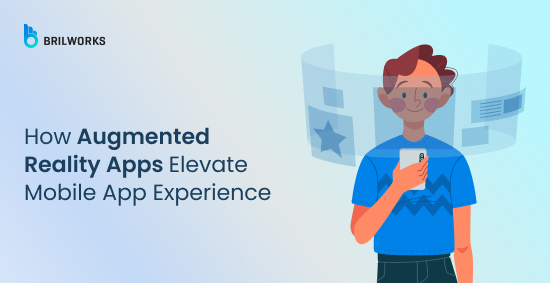
Anyone who’s ever pointed their phone at a strange-looking plant to identify it—or scanned a product to find it online using Google Lens—has already experienced augmented reality in action.
As technology advances, augmented reality (AR) in mobile apps is becoming more popular. Virtual reality (VR) and augmented reality (AR), which at first seemed futuristic, are rapidly integrating into daily life. AR is being incorporated and utilised in a wide range of innovative, useful applications, from gaming and e-commerce to IT and healthcare.
According to reports, more than 1.03 billion people were actually utilising mobile AR by the end of 2024, using web tools, apps, and even visual search. By 2025, that figure is anticipated to rise to 1.07 billion, and by 2028, it is predicted to reach 1.19 billion. It's safe to say that AR is rapidly becoming a fundamental component of mobile app development and is no longer a novelty.
In this blog, we’ll explore how AR is enhancing mobile apps, the real-world use cases that are gaining traction, and why now is a great time to consider AR app development for your own product or business.
Let’s understand AR in simple terms, then we’ll come to the mobile apps. The phrase “augmented reality” breaks down into two parts: “augmented” and “reality.” As these two words suggest, you are literally augmenting reality. But that reality exists only within your mobile phone. It is a kind of technology that adds digital content like images, text, or 3D objects on top of the real world, usually through a smartphone camera.
So instead of looking at just your surroundings, AR lets you see extra digital things layered over them. For example, when you use your phone to see how a new couch would look in your room or scan a plant to learn its name, that’s AR in action.
So how does it work? AR on smartphones typically relies on the phone’s camera, GPS, accelerometer, and sometimes LiDAR sensors to detect the environment and position digital elements accurately. Thanks to AR development kits like ARKit (for iOS) and ARCore (for Android), developers can create these immersive experiences without building everything from scratch. We will discuss this in detail later.
AR in apps is becoming more widely available and practical, from scanning QR codes to exploring 3D models, and it's altering users' expectations for mobile experiences.
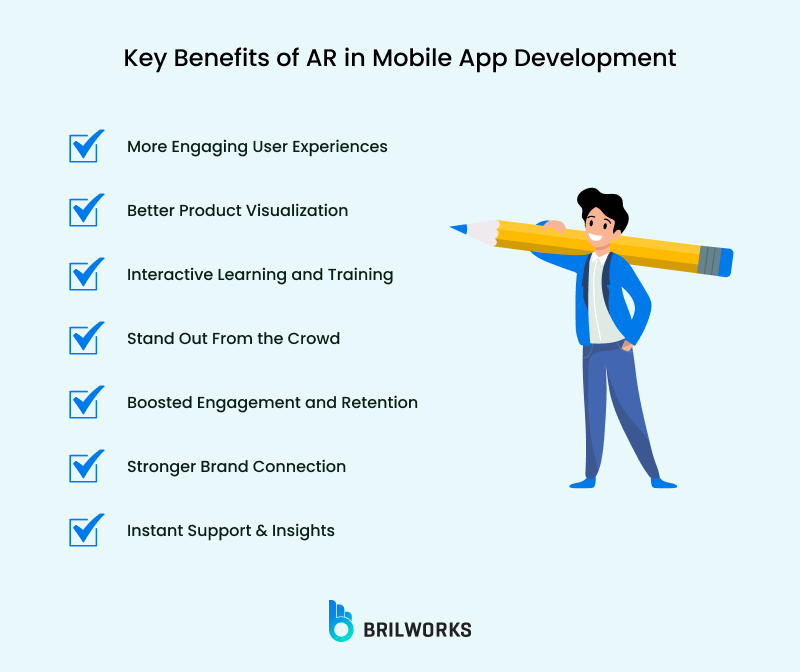
Here are some of the biggest ways augmented reality apps are making mobile experiences smarter, more interactive, and way more useful:
Features are what make the app successful. People are inundated with apps every day. However, AR brings something new: interaction. With AR features users can move, explore, and interact with realistic-feeling digital content rather than merely tapping or scrolling. AR produces a lifelike experience, whether you're arranging furniture in your living room or experimenting with a filter that reacts to your facial movements. Users are drawn in and apps become more enjoyable, immersive, and ultimately memorable when this degree of interaction is present.
The inability to try before you buy is one of the main annoyances of online shopping. AR alters that. Users can now preview a new sofa in the living room or check how a pair of sunglasses fits by using augmented reality in apps. Purchase confidence increases, trust increases, and uncertainty decreases with this type of real-world visualisation. For companies, that translates into more satisfied clients and fewer returns.
When learning something new is just text and theory, it can be overwhelming. However, AR in apps makes education and training more engaging. Consider an app that walks medical students through a 3D model of a heart or that walks a technician through a repair procedure step-by-step on their phone. AR helps students understand abstract ideas and allows them to use what they've learnt in real-world situations, which increases confidence and retention.
It's difficult to stand out in the fiercely competitive field of mobile app development. However, AR-enabled apps frequently have that extra spark that makes people talk. AR helps apps stand out from the competition, whether it's through an inventive way to overlay information on the real world, a fun mini-game, or a unique try-on experience. It's a feature that adds value and can elevate an ordinary app to something extraordinary, not just a novelty.
Users are more likely to stay with your app if it is entertaining or helpful, and augmented reality undoubtedly helps with both. It encourages users to return more often, engage with the app more, and spend more time there. The hands-on aspect of AR app development results in greater engagement and retention over time, whether users are solving puzzles in their own surroundings or scanning real-world objects to unlock content.
Experiences are what users remember the most in an app, not just features. Apps for augmented reality also have a way of elevating ordinary moments. A simple product demo can become something poignant, viral, and even magical with a well-designed augmented reality experience. Through these kinds of interactions, brands are able to establish emotional bonds with consumers, which increases brand loyalty, encourages word-of-mouth, and creates memorable brand experiences.
AR is excellent at providing users with the assistance they need when they need it. AR in apps provides real-time help, from guiding users through the process of assembling furniture to assisting them in identifying a technical problem by pointing their camera at a device. In addition to increasing users' sense of support, this lessens the need for tiresome back-and-forth emails or protracted support calls. It's a clever method to increase customer satisfaction while saving companies money and time.

Augmented reality has come a long way since its early days. Today, it's being used in a wide range of industries and applications, improving user experiences, boosting business outcomes, and even making everyday tasks easier. Here are some of the most popular use cases of AR in apps that are changing the game:
With good reason, the retail sector has embraced AR quickly. Without physically entering a store, customers can virtually try on clothing, view furniture in their homes, and even try on different shades of makeup. This boosts customer confidence and lowers returns. Additionally, the immersive experience prolongs customer engagement, which can directly increase sales.
Example: IKEA Place, Amazon AR View, Sephora Virtual Artist
Many people first came into contact with AR through gaming, which remains one of its most intriguing applications. AR games provide more immersive gameplay by fusing digital and real-world elements. Players participate in the action rather than merely observing it. AR adds a whole new level of interaction, whether you're solving puzzles, capturing creatures, or exploring fantasy worlds.
Example: Pokémon GO, Harry Potter: Wizards Unite, Jurassic World Alive
AR makes navigating new locations much simpler. Users can follow arrows and directions superimposed directly on their camera view, eliminating the need to read a small map or make educated guesses about where to go. As visitors explore landmarks, augmented reality (AR) provides additional value by presenting historical facts or fascinating trivia.
Example: Google Maps Live View, Citymapper, ViewRanger
AR makes learning more dynamic. Students can use their devices to explore the solar system and ancient Rome in three dimensions instead of reading about them. It also helps with difficult subjects like biology and engineering by providing detailed, visual explanations that make difficult ideas simpler to comprehend and retain.
Example: Google Expeditions, Merge EDU, Human Anatomy Atlas AR
Considering remodelling your house? Visualising changes before committing is made easier with AR. AR apps give users more confidence when designing by allowing them to preview furniture layouts and try out paint colours. To cut down on guesswork and expensive mistakes, some apps even walk users through do-it-yourself tasks or installations.
Example: Houzz, Roomle
AR isn't just futuristic; it's already having a significant influence on healthcare. During procedures, surgeons use it to visualize organs in real time. Therapists guide patients through rehab exercises using AR-powered mobile apps with live feedback. Plus, features like interactive medication tracking and symptom checkers in healthcare apps help users better understand instructions and manage care from their phones.
Example: AccuVein, EyeDecide, Touch Surgery
Static photos and lengthy tours are no longer the only options for house hunting. With AR, potential tenants or buyers can see how their furniture would fit in a space or take immersive virtual tours of properties. AR is also used by real estate agents to display floor plans in a more dynamic and captivating manner.
Example: Magicplan
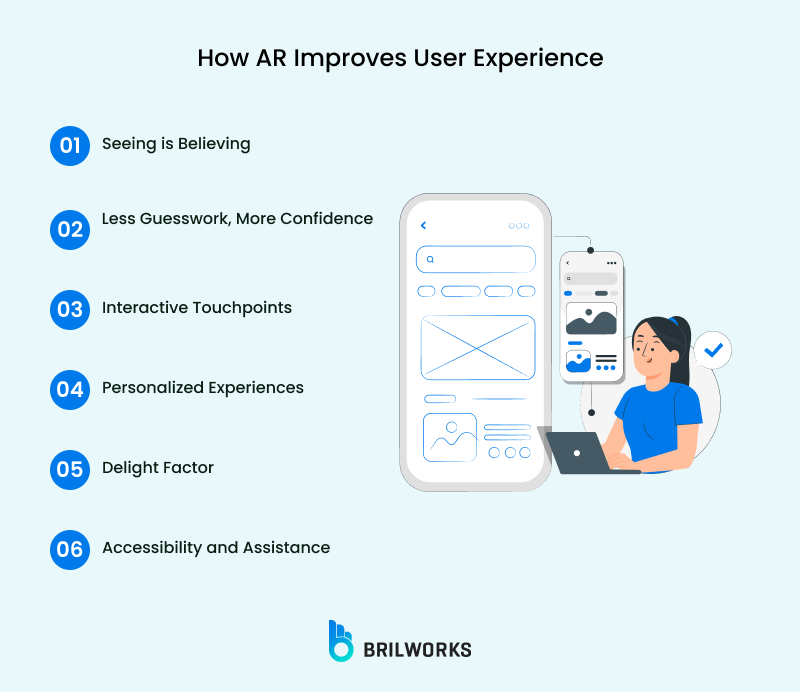
An application's user experience (UX) can make or break it. Furthermore, simply being functional is insufficient in the cutthroat mobile market of today. This is where augmented reality applications truly shine; they do more than just function well; they add excitement, utility, and personalisation to the app-using experience.
Here’s how AR enhances user experience in meaningful ways:
AR enables users to engage with content within their actual environment. They can see a product in action in their space rather than just envisioning how it will appear or work. AR in apps greatly improves the user experience, whether it's setting up a new desk in the home office or determining whether a pair of trainers goes with an outfit.
With AR, users can:
Visualize products in their own space
Rotate and inspect items in 3D
Make faster, more confident purchase decisions
It turns passive scrolling into active exploration.
Due to the inability to "try before they buy," people frequently hesitate when making decisions online. By enabling users to navigate environments, see products, and comprehend how things operate without any doubt, augmented reality fills that gap. As a result, decisions are made more quickly, returns are reduced, and brand trust increases.
AR app development incorporates layers of movement, scanning, and real-world interaction, in contrast to traditional mobile app development, which restricts interaction to swiping or tapping. The app feels more alive and responsive to the user's surroundings thanks to these touchpoints, which also prolong user engagement.
AR applications can create a highly customised experience by adjusting to the actions and surroundings of each user. The experience becomes customised by modifying content according to lighting, location, or actual objects—something that is difficult for standard interfaces to accomplish.
When digital objects seem to "exist" in your environment, there is a sense of surprise and delight. Users develop a closer bond with the app as a result of that emotional reaction, which also keeps them using it for enjoyment.
AR provides real-time help that makes apps more accessible to a wider range of users, from language translation to object identification and step-by-step instructions. It can make difficult tasks easier, transforming frustration into ease.
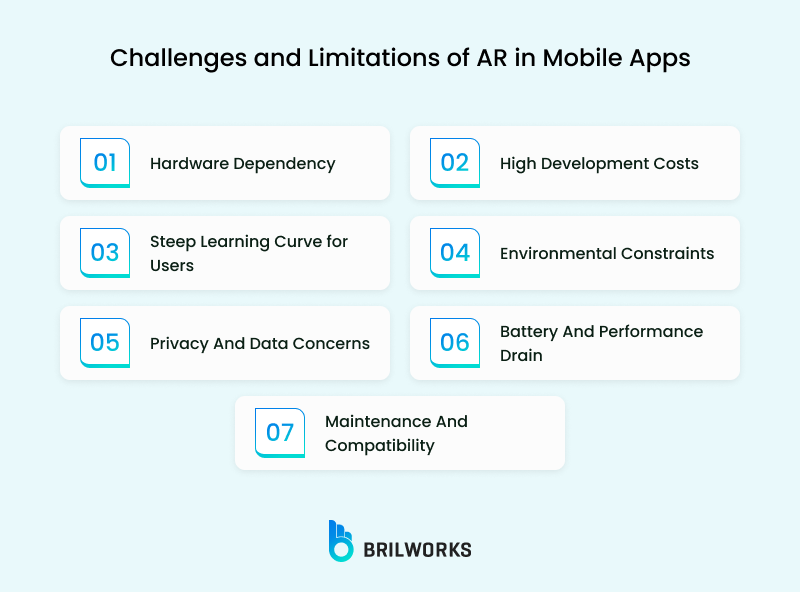
While AR brings a futuristic touch to mobile apps, it also comes with its own set of hurdles. From technical barriers to user friction, here are some of the key challenges developers and businesses face in AR app development:
Not every smartphone is designed with augmented reality in mind. High-end hardware, such as sophisticated cameras, sensors, and processors, is necessary for many AR features to function as intended. Because of this, developers must take into account a user base that is fragmented, meaning that not everyone can enjoy the entire experience.
Key limitations include:
AR features may not work on older or low-end smartphones
Lack of depth sensors and camera quality can reduce accuracy
User experience varies widely depending on the device
Compared to traditional mobile app development, creating augmented reality apps frequently takes more time, knowledge, and resources. The labour-intensive process, which includes 3D modelling and real-time rendering, can increase complexity and cost.
What adds to the cost:
Hiring specialists for AR design and development
Purchasing or licensing AR development tools and platforms
Investing in continuous testing and iteration
Users who are not familiar with the operation of even the best-designed augmented reality app may become confused. It may not seem obvious at first, but AR requires users to interact with their surroundings, unlike traditional app interfaces.
Challenges users may face:
Difficulty understanding how to launch or use AR features
Lack of proper onboarding or tutorials
Frustration with gestures, camera alignment, or controls
Not every environment is a good fit for AR. The app's ability to accurately map its environment can be impacted by real-world elements like lighting, space, and background clutter.
Common issues include:
Poor lighting or overexposure reduces tracking accuracy
Highly reflective or patterned surfaces confuse object placement
Limited physical space restricts interaction
Due to their heavy reliance on a device's location and camera, augmented reality apps frequently require access to private user information. Particularly if users don't fully comprehend what the app is doing, this may give rise to privacy concerns.
Privacy concerns typically revolve around:
Camera and microphone access
Real-time location tracking
Collection of environmental data without transparency
The resources of the device are heavily taxed when using AR features. Users may encounter lag, overheating, or rapid battery drain if the app isn't optimised, all of which have a detrimental impact on user satisfaction.
Performance bottlenecks can include:
High GPU/CPU usage during AR rendering
Background processes interfering with smooth operation
Quick battery depletion during extended AR use
In our blog, we mentioned that one of the key reasons why mobile app testing is critical was AR & VR applications. AR technology is developing quickly. AR apps require regular updates to remain functional and relevant, not only to address bugs but also to remain compatible with evolving software and hardware standards.
This adds ongoing development effort such as:
Updating SDKs like ARKit or ARCore regularly
Testing across multiple devices and OS versions
Fixing issues caused by platform or device fragmentation
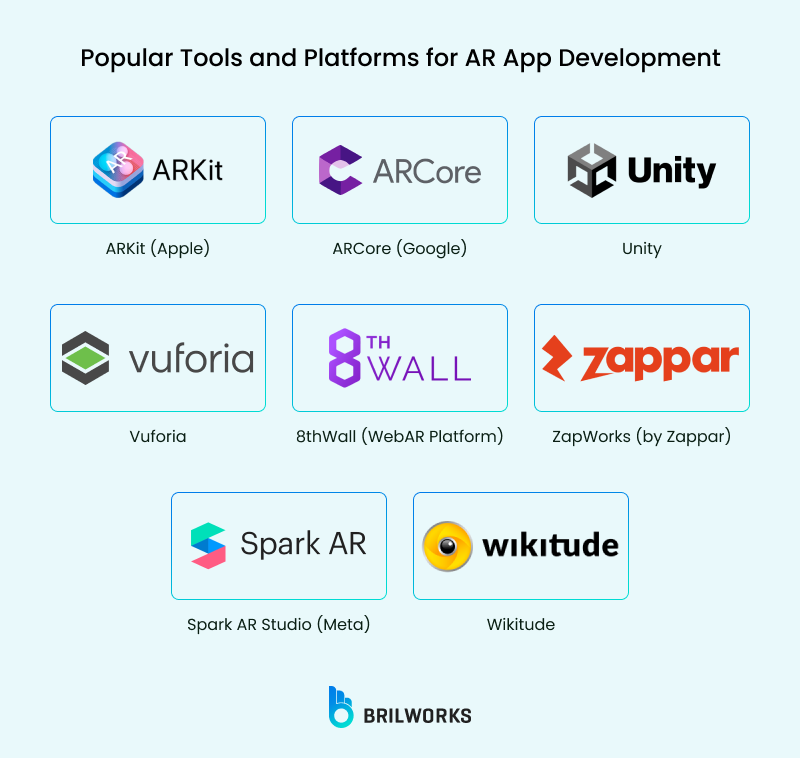
Creating high-quality augmented reality apps has become much more accessible thanks to a variety of powerful development tools and platforms. These tools help developers design, build, and deploy immersive AR experiences for mobile devices without reinventing the wheel.
Here are some of the most popular platforms used in AR app development today:
ARKit is Apple’s proprietary framework for building AR experiences on iOS devices. It uses the camera, motion sensors, and advanced machine learning to enable high-quality AR interactions.
What it offers:
Scene understanding: Detect planes (like floors and tables), estimate lighting, and place digital objects realistically.
Face tracking: Ideal for face filters, avatar creation, and virtual try-ons.
Lidar support: Newer iPhones and iPads can leverage LiDAR sensors for more accurate depth sensing.
Best for: iOS-exclusive augmented reality apps that demand precision, realism, and strong performance.
ARCore is Google’s platform for building AR experiences on Android. It provides similar capabilities as ARKit but is designed for a broader range of Android devices.
Features include:
Environmental understanding: Detects surfaces and estimates lighting for more realistic visuals.
Cloud Anchors: Enables shared AR experiences between users.
Geospatial API: Anchors digital content to real-world locations using Google Maps data.
Best for: Developers targeting Android or building cross-platform AR in apps using Unity.
Unity is a powerful 3D development platform often used for creating immersive AR and VR experiences. While it isn’t an AR SDK by itself, it supports several AR plugins, including AR Foundation, ARKit, ARCore, and Vuforia, making it incredibly versatile.
Cross-platform support for Android, iOS, and other platforms
Robust 3D engine with real-time rendering and animation capabilities
Extensive asset store and community for faster development
Ideal for games, simulations, and interactive 3D experiences
Often paired with AR SDKs like Vuforia to enable AR-specific features
Best for: High-quality, cross-platform AR/VR apps with 3D interactivity and custom animations
Vuforia is a widely-used AR SDK that enables apps to recognize and interact with real-world images and objects. It’s highly regarded for its precision and ease of use, and integrates smoothly with Unity.
Advanced image and object recognition features
Model target tracking for recognizing 3D objects and CAD models
Supports ground plane detection and extended tracking
Compatible with Unity and native development environments
Great for industrial, retail, and educational AR applications
Best for: Marker-based AR experiences that rely on object detection, 3D tracking, and real-world interaction
8thWall makes it possible to create web-based AR (WebAR) experiences that run directly in mobile browsers—no app download required.
Why it’s unique:
Instant access: Reduces friction by letting users experience AR via a link or QR code.
Great for marketing: Perfect for product launches, brand activations, and campaigns.
Cross-device support: Compatible with most smartphones regardless of OS.
Best for: Marketers and developers who want to create lightweight, accessible, and highly shareable AR in apps (without actual app installs).
ZapWorks is designed for creators and marketers looking to design interactive AR campaigns without deep technical expertise.
Key strengths:
Drag-and-drop interface: Simple for non-developers but still powerful for pros.
Custom triggers: Use QR codes, images, or even face detection to launch AR experiences.
Analytics built-in: Track user engagement and performance metrics.
Best for: Agencies, educators, and businesses creating short-form or branded AR experiences.
Spark AR lets developers and creators create augmented reality filters and effects for Meta’s social platforms, including Instagram, Facebook, and Messenger.
What it excels at:
Social integration: Direct publishing to a massive user base.
No-code support: Offers visual tools for easy creation, though scripting is available for advanced effects.
Real-time face tracking and gestures: Perfect for interactive filters.
Best for: influencers, brands, and creators looking to create viral AR content in social media apps.
Wikitude is a versatile and mature AR development platform that supports both marker-based and markerless tracking, image recognition, and geolocation-based AR. It also integrates smoothly with Unity and supports both native and web-based apps.
What makes it unique:
Supports SLAM (Simultaneous Localization and Mapping) for dynamic environments
Combines AR with location-based services
Works across Android, iOS, and smart glasses
Best for: Location-based AR app development, enterprise use cases, and cross-device AR solutions.
Also read: Best Mobile App Development Platforms

If we've learnt anything, it's that augmented reality is more than just a fad. Through our mobile devices, it is changing the way we perceive the world. AR apps are adding a magical touch to routine tasks, making them more interesting, educational, and enjoyable in a variety of contexts, including retail, education, and entertainment.
Why now, then? Why should you start considering augmented reality for your mobile app now? The short answer is that augmented reality technology has advanced to a point where it is now more widely available, reasonably priced, and user-friendly than ever. The possibilities for innovation are limitless, and users and the tools are prepared.
Perhaps now is the ideal moment to investigate how augmented reality (AR) in apps can elevate your app to a new level. Why wait, then? Let's see where the world of augmented reality can lead you.
Ready to develop your mobile app? Let's turn your ideas into reality. Contact us today to get started on your app development journey.
Augmented reality (AR) in mobile apps overlays digital content, like images, animations, or information, onto the real world through a smartphone camera.
AR is used in retail for product previews, in education for interactive learning, in healthcare for guided procedures, and in gaming for immersive experiences.
Most AR apps run on standard smartphones with a camera and sufficient processing power. Some advanced apps may benefit from newer devices or AR-specific platforms.
The cost can vary based on app complexity, features, and the platform used. However, tools like ARKit, ARCore, and Unity help streamline development.
Yes, AR creates more interactive and memorable experiences, increasing user engagement, brand recall, and time spent within the app.
Get In Touch
Contact us for your software development requirements
Get In Touch
Contact us for your software development requirements